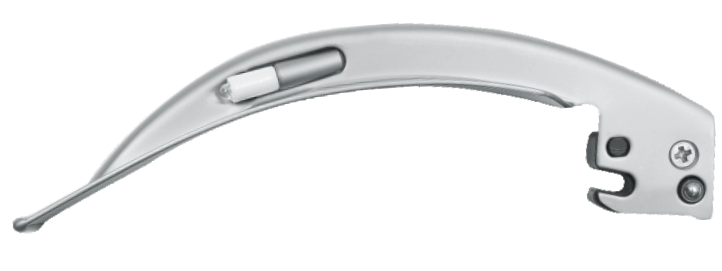Laryngoscope Blades
Laryngoscope blades are fundamental components of laryngoscopes, pivotal in providing optimal visualization of the larynx during intubation and airway management procedures. In this comprehensive guide, we delve into the world of laryngoscope, exploring their various types, uses, and essential considerations for healthcare professionals.
It is designed to fit onto the handle of a laryngoscope and provide a clear view of the larynx by lifting the epiglottis and surrounding structures. They come in a range of shapes, sizes, and materials, each tailored to specific patient anatomies and clinical scenarios.
Types of Laryngoscope Blades:
Macintosh Blade (Curved Blade): The Macintosh blade is the most commonly used laryngoscope blade, featuring a curved design that facilitates lifting of the epiglottis to expose the vocal cords. It is particularly well-suited for routine intubations and patients with normal airway anatomy.
Miller Blade (Straight Blade): The Miller blade is characterized by its straight, elongated shape, which allows for direct visualization of the vocal cords without lifting the epiglottis. It is often preferred for patients with limited mouth opening, large tongues, or anterior larynx.
Wisconsin Blade: The Wisconsin blade combines elements of both the Macintosh and Miller designs, featuring a curved shape with a flattened tip for optimal epiglottis elevation and visualization of the glottis.
Pediatic Blades: Pediatric blades are specifically designed for use in pediatric patients, featuring smaller sizes and modified shapes to accommodate the anatomical differences of children.
Considerations for Choosing Laryngoscope Blades:
Clinical Scenario: Consider the clinical scenario and intubation difficulty when choosing between Macintosh, Miller, or specialty blades to optimize laryngeal visualization and intubation success.
Blade Size: Choose the appropriate blade size based on patient age, weight, and airway size, ensuring proper fit and optimal laryngeal exposure.
Blade Material: Laryngoscope blades are typically made from stainless steel or durable polymers. Consider the material’s durability, ease of cleaning, and compatibility with sterilization methods.
Maintenance and Care:
Cleaning and Disinfection: Follow manufacturer-recommended protocols for cleaning and disinfecting blades after each use to prevent cross-contamination and ensure patient safety.
Inspection: Regularly inspect laryngoscope blades for signs of wear, damage, or corrosion, and replace any worn or damaged blades promptly to maintain optimal performance.
Storage: Store laryngoscope blades in a clean, dry environment away from direct sunlight and moisture to prevent deterioration and microbial growth.
Conclusion:
Laryngoscope blades are essential tools in airway management, offering a diverse range of shapes, sizes, and designs to suit various patient anatomies and clinical scenarios.
By understanding the different types of blades, considering key factors in blade selection, and prioritizing proper maintenance and care, healthcare professionals can ensure optimal laryngeal visualization and intubation success in diverse clinical settings.

